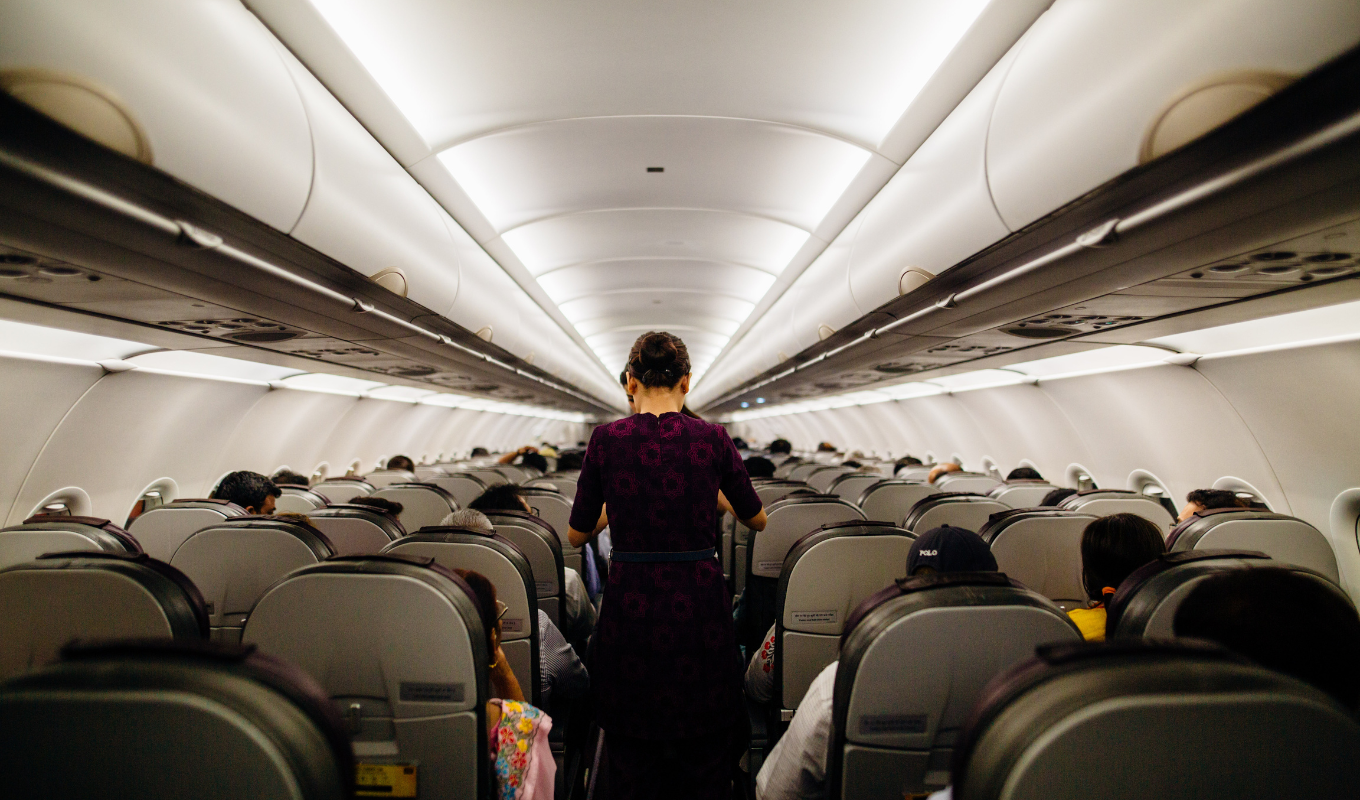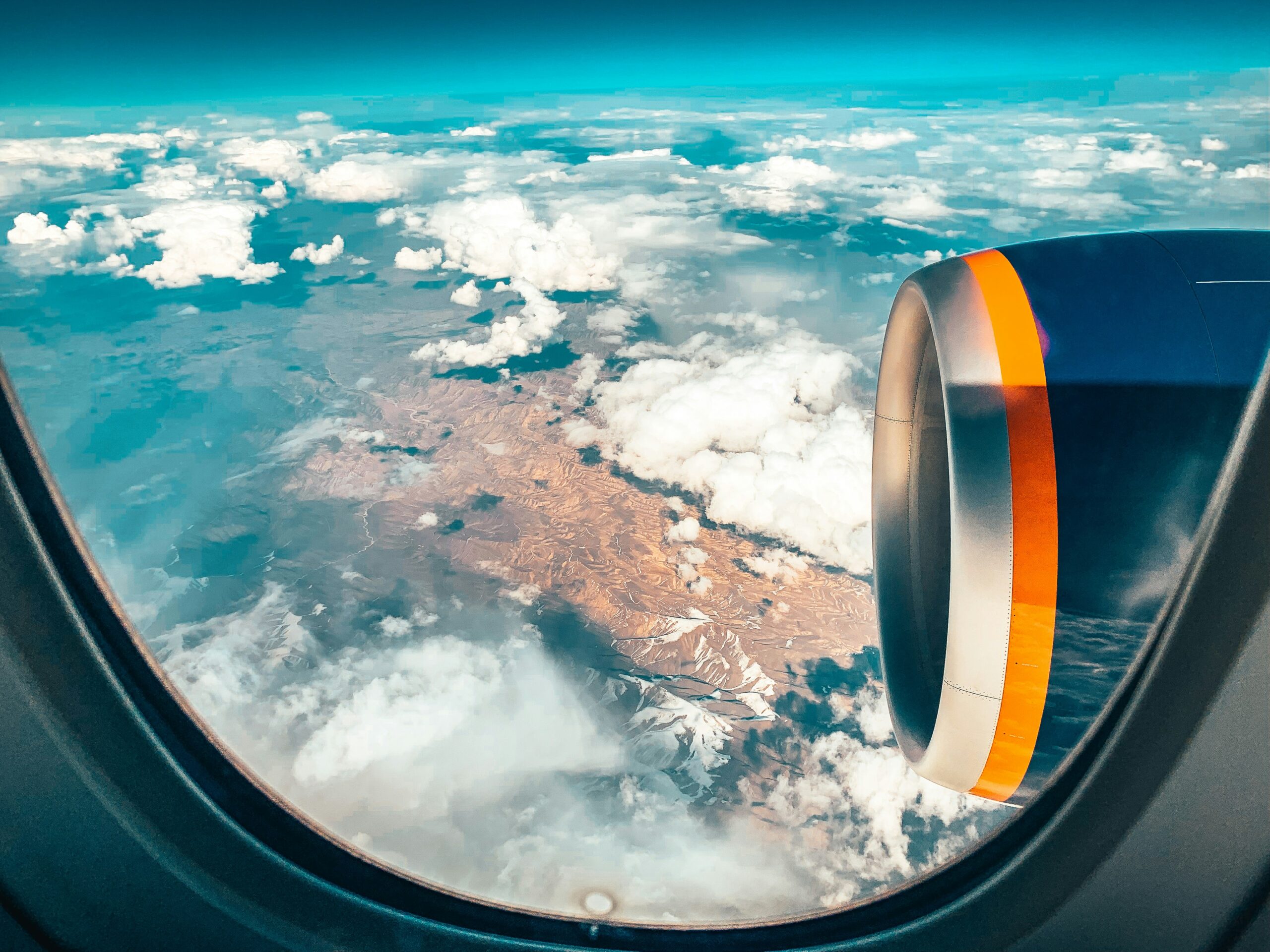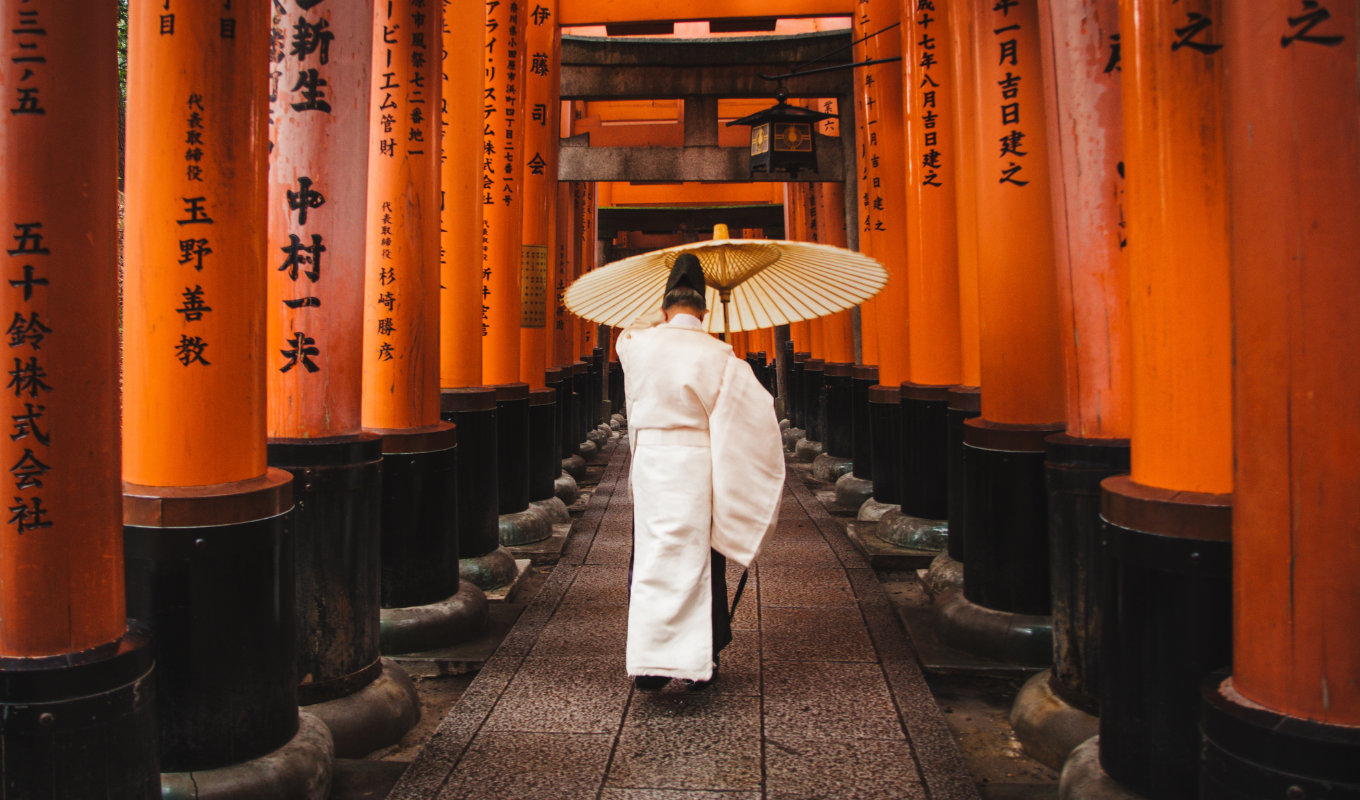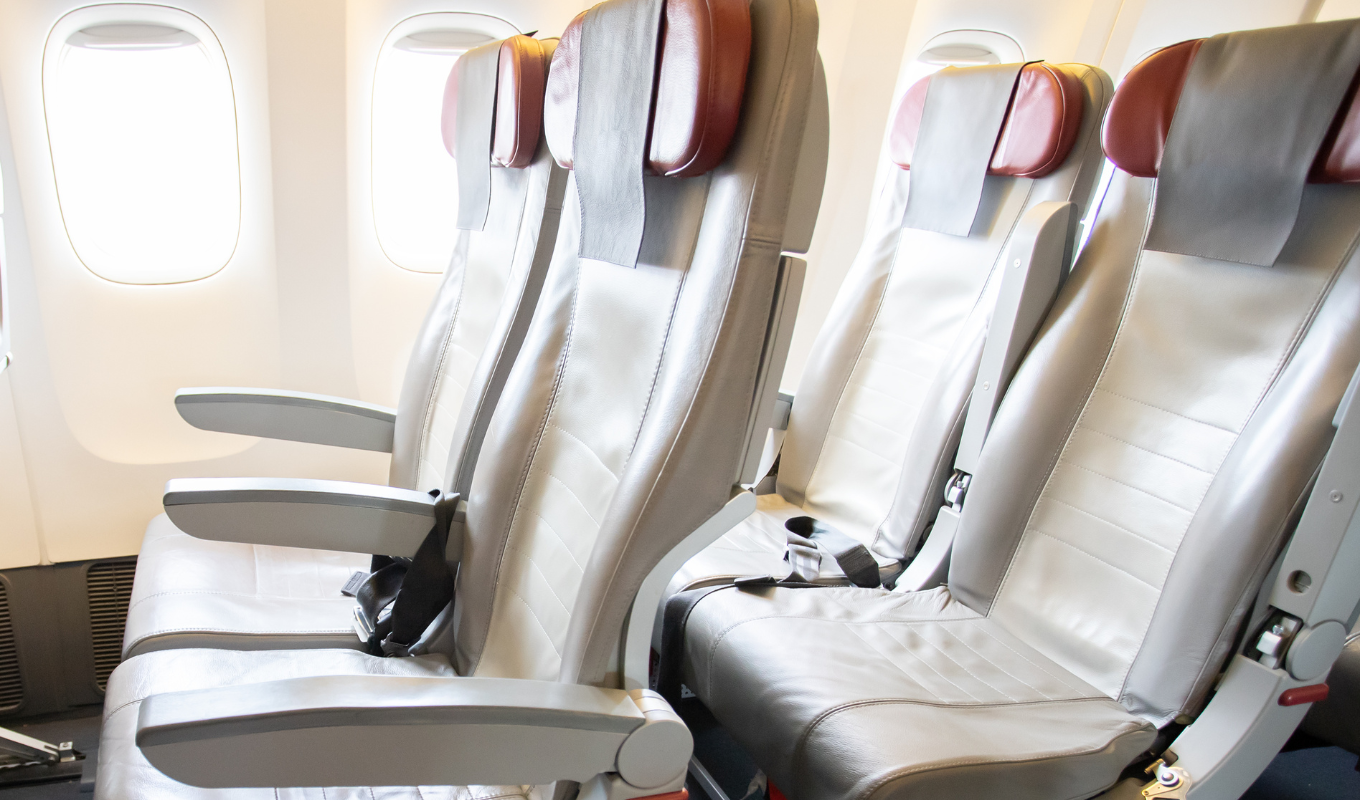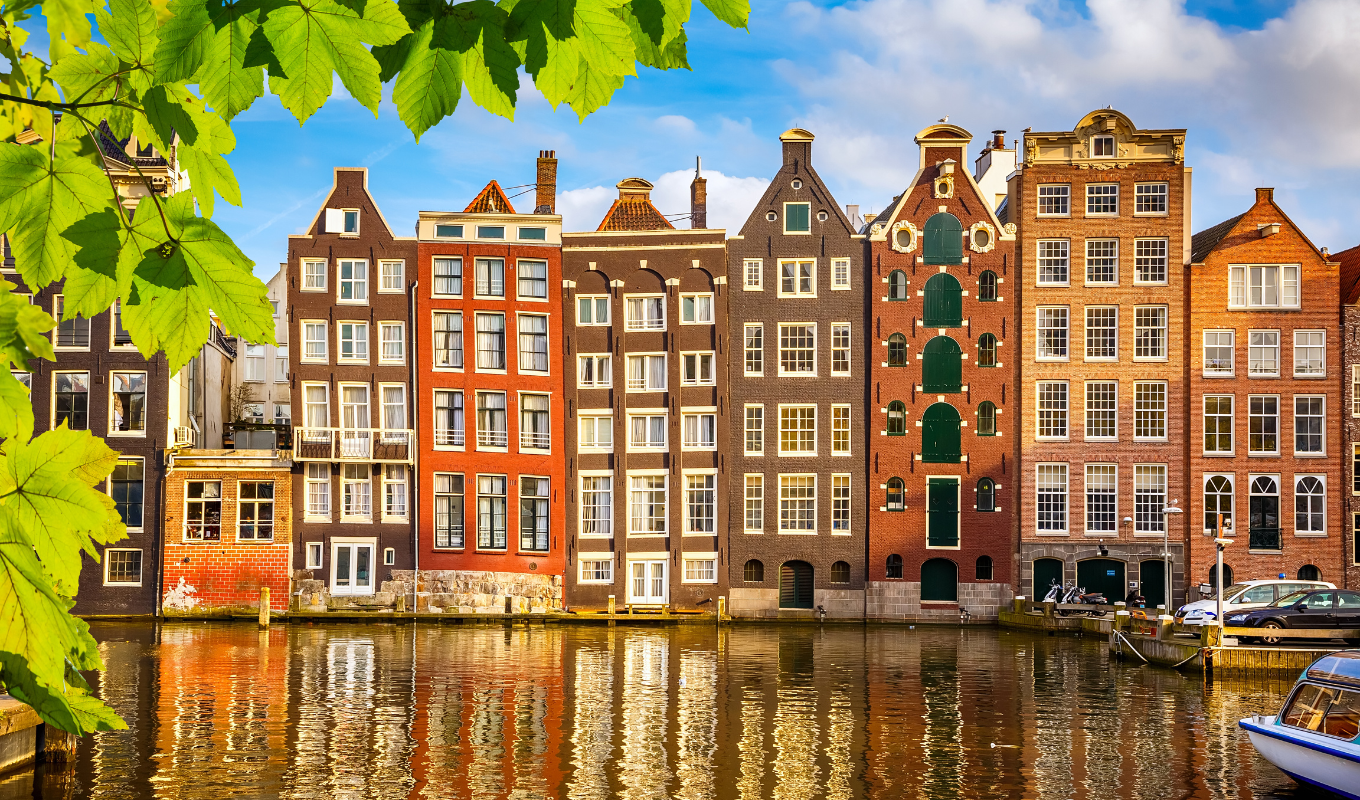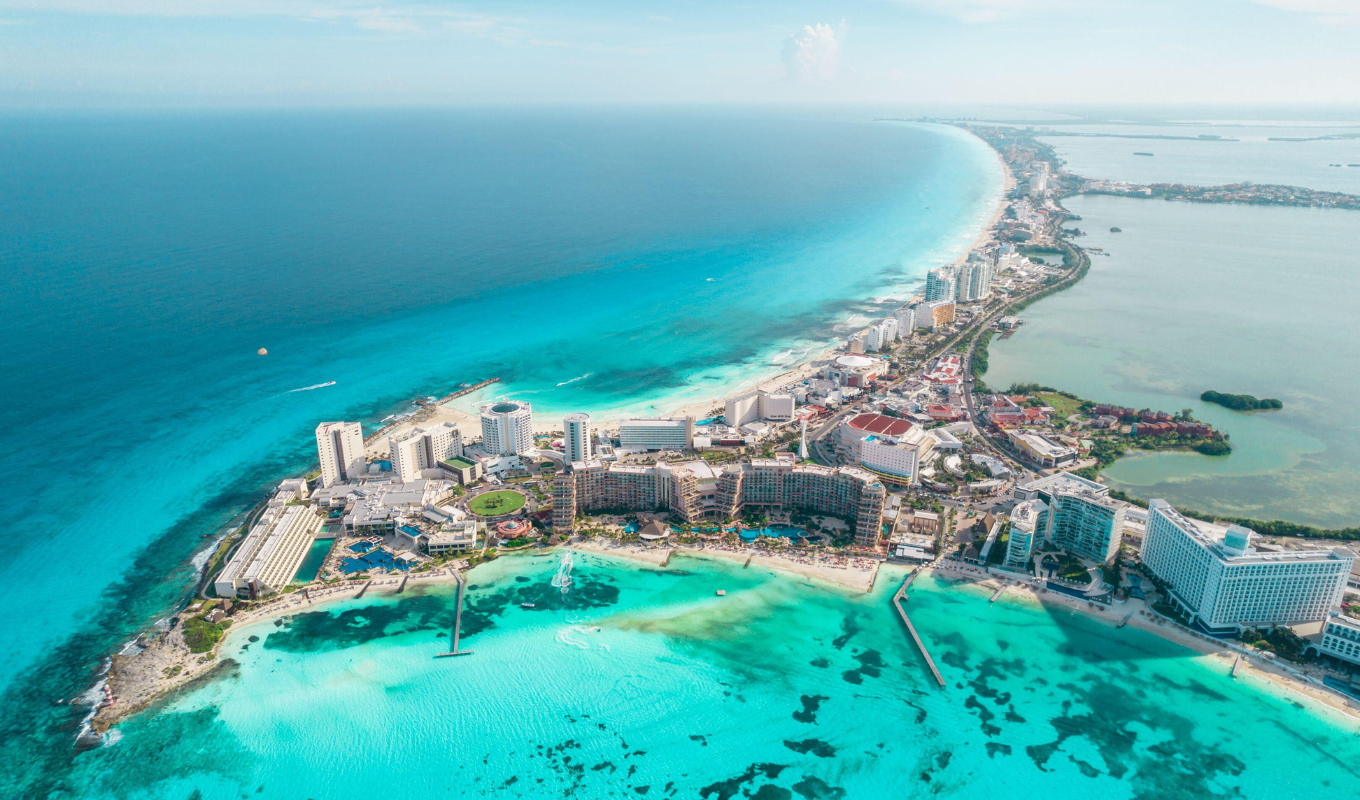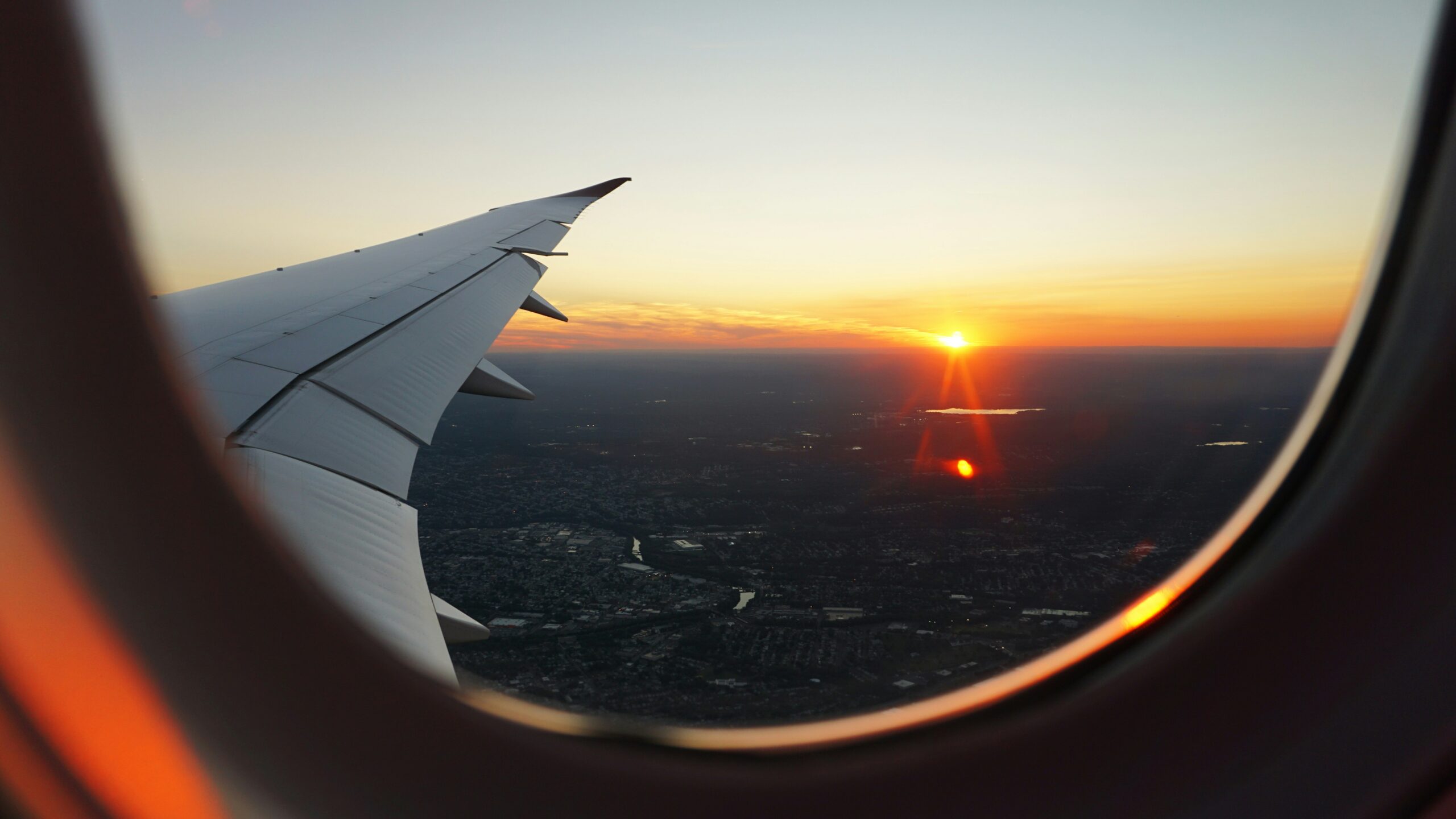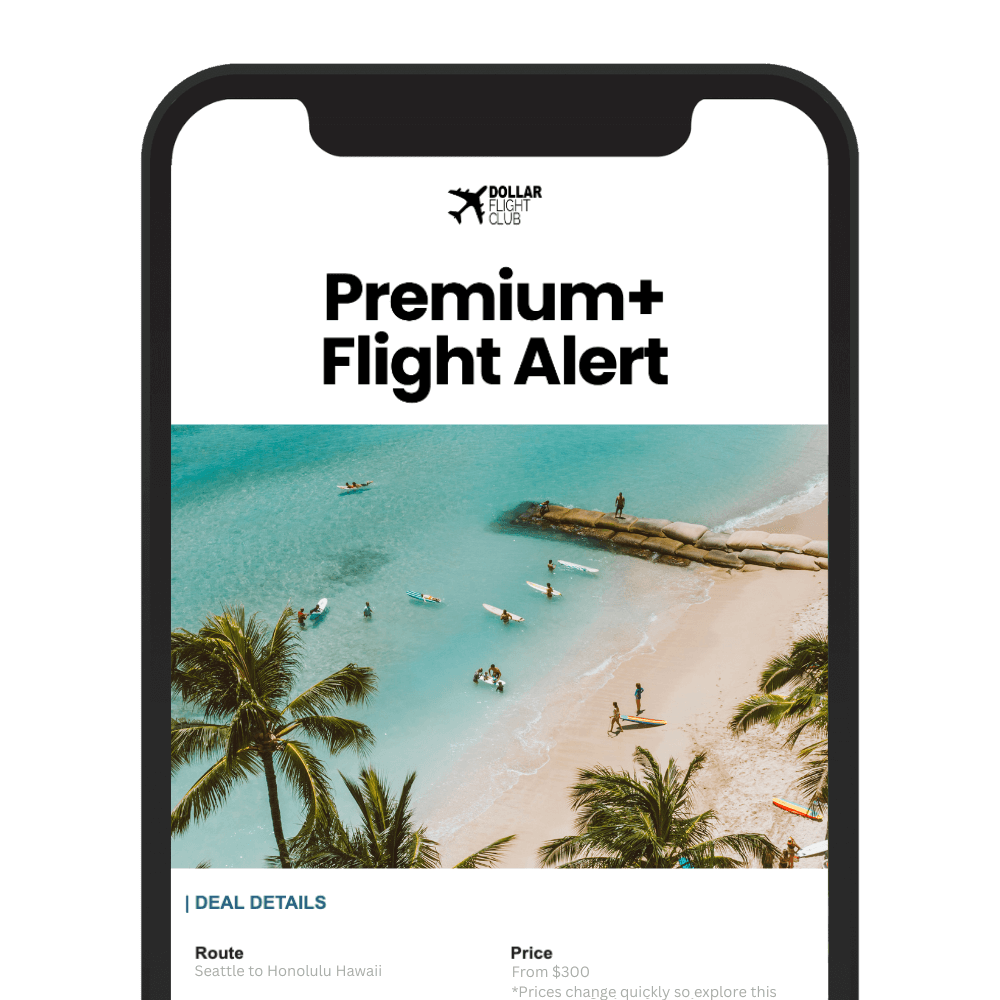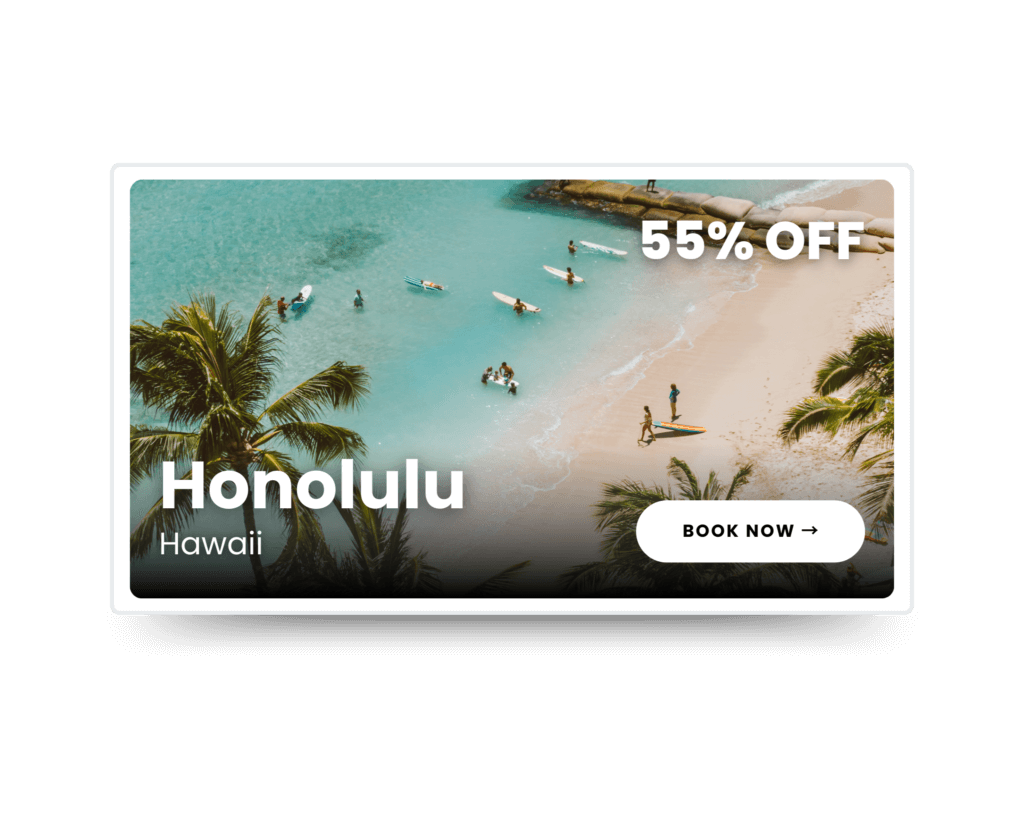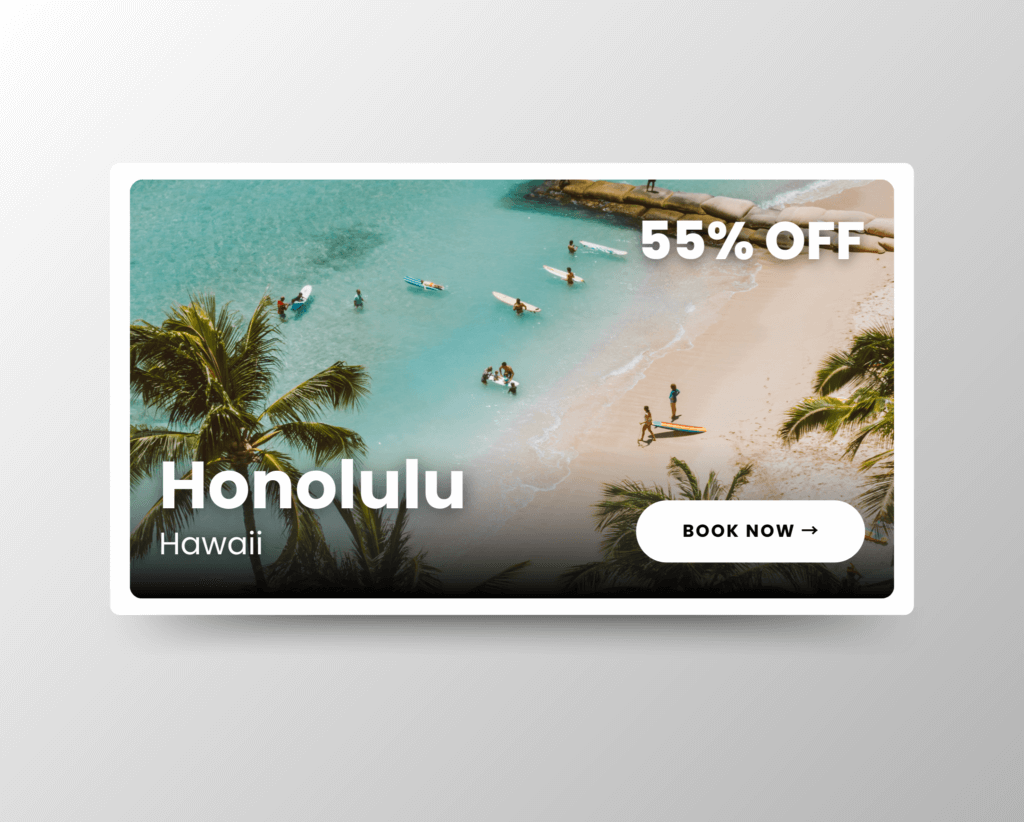When booking a flight, your choice of seat class can shape your entire travel experience. Airlines generally offer four main options: Economy, Premium Economy, Business, and First Class. Each class comes with its own perks, comfort levels, and costs.
- Economy Class: Budget-friendly, basic comfort, limited legroom, and simple meal options. Average domestic ticket: $316.
- Premium Economy: A step up from Economy with more space, better meals, and added perks. Average domestic ticket: $732.
- Business Class: Designed for comfort and productivity with lie-flat seats, priority services, and gourmet dining. Average domestic ticket: $1,784.
- First Class: The ultimate luxury with private suites, high-end dining, and exclusive amenities. Average domestic ticket: $846.
Ticket prices vary widely depending on route, airline, and travel dates. For international flights, Economy averages $868, while First Class can reach $4,361 or more. Understanding these options helps you pick the right balance of cost and comfort for your trip.
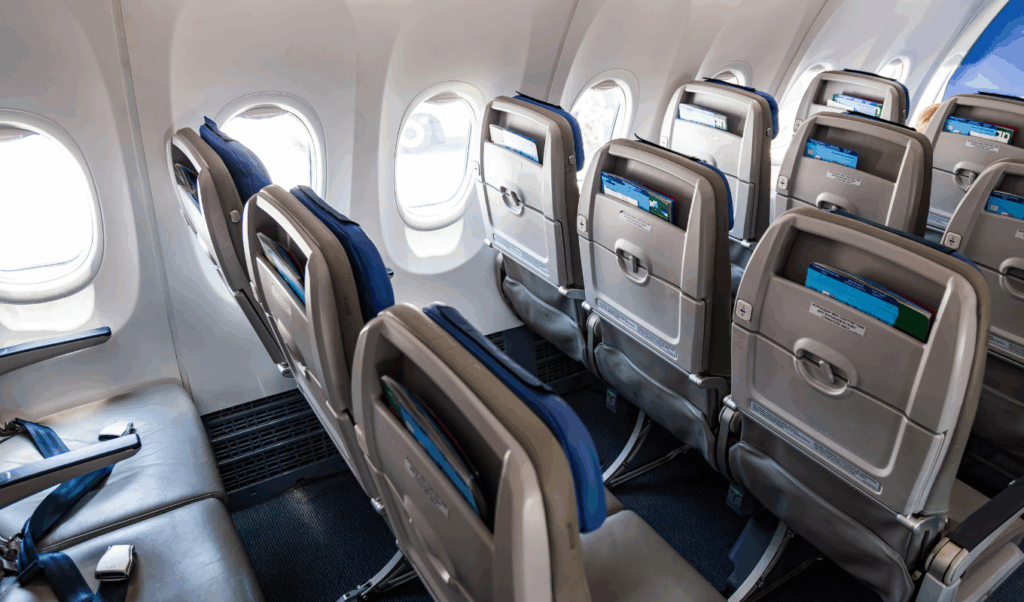
Economy Class
Economy class is the go-to option for budget-minded travelers, offering an affordable way to get from point A to point B without breaking the bank.
Economy Class Features
Seating and Space
Economy seating is designed for practicality, providing legroom of about 30–34 inches (commonly referred to as “pitch”) and seat widths ranging from 17 to 18.5 inches. On international flights, you might get a bit more legroom – 32–34 inches – while domestic flights typically stick to 30–31 inches. The seats are functional, with limited recline, focusing on getting you there, not pampering you.
Baggage Allowances
Most full-service international airlines allow passengers to bring a carry-on bag, a personal item (weighing between 15 and 22 pounds), and one or two checked bags, each up to 50 pounds. Some airlines go above and beyond: Qatar Airways and Emirates, for example, often include one free checked bag up to 55 pounds, while Japan Airlines frequently permits two checked bags at no extra cost.
In-Flight Entertainment and Connectivity
On long-haul flights, you’ll often find seatback screens or streaming options for your devices, offering movies, TV shows, music, and even flight trackers. Newer planes typically include USB charging ports. Some airlines, like Qatar Airways and JetBlue, have stepped up their game by offering free Wi-Fi for all passengers.
Food and Beverage Service
Meal offerings can vary widely. On long international flights, you can expect complimentary full meals, which might include bread, salad, a hot entrée, dessert, and snacks for the journey. On shorter flights, the options are simpler – think pretzels, nuts, or cookies. Drinks like water, soda, juice, tea, and coffee are usually free, but alcohol may cost extra on domestic routes. Airlines such as Japan Airlines stand out with gourmet meals featuring dishes like smoked salmon, paired with sake selections.
Amenities and Extras
For international flights, economy passengers may receive basic comforts like adjustable headrests, pillows, and blankets. Some airlines also provide amenity kits with items like socks, eye shades, and dental kits. Additional services – such as assistance for passengers with disabilities, bassinets for infants, and special meals for dietary needs – are generally available upon request.
What You’ll Pay Extra For
To keep ticket prices low, airlines charge for upgrades and extras. Want more legroom? Exit row or Economy Plus seats will cost extra. Similarly, in-flight Wi-Fi (on some carriers), upgraded meals, and alcoholic drinks on domestic flights come with additional fees. Even basic items like pillows and blankets may only be free on international routes.
These cost-saving measures make economy class a practical choice for those who value affordability over added comforts.
Who Should Choose Economy Class
Economy class works well for anyone looking to save money – students, families, tourists, and even business travelers who prioritize affordability over luxury. It’s especially practical for short to medium flights (roughly 4–5 hours or less) or for light packers who don’t need to check multiple bags.
Families or groups traveling together can benefit from the cost savings, but make sure to review the airline’s seat selection policy. Some basic economy fares assign seats randomly, so paying a little extra to sit together might be worth it.
While economy class may lack the spacious seating and personalized service of premium cabins, the trade-off is undeniable: significant savings. Economy fares are often 30–50% cheaper than premium economy and can be up to 80% less than business class. For travelers who value affordability above all else, economy class is the obvious choice.
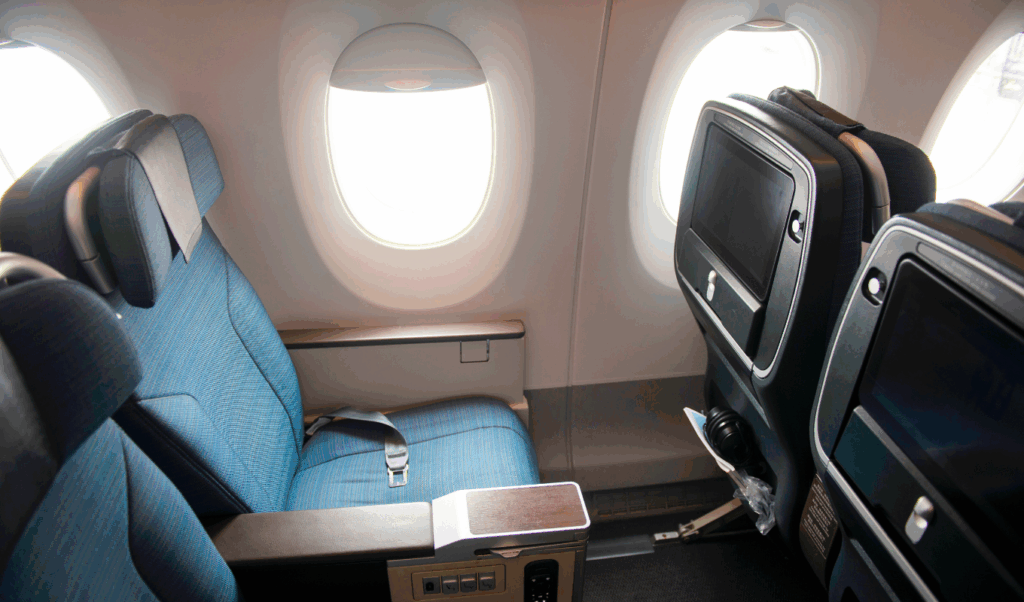
Premium Economy Class
Premium economy bridges the gap between standard economy and business class, offering travelers a step up in comfort without the steep cost of premium cabins. It’s become a popular choice for those who want more than the basics but can’t justify the expense of business class.
What Premium Economy Offers
Premium economy takes the essentials of economy class and upgrades them, delivering a more comfortable and enjoyable travel experience.
Seating and Space
One of the standout features of premium economy is the extra space. Seats typically offer a pitch of 38–42 inches, compared to the 30–32 inches in standard economy. The recline is also much better – around 7–9 inches versus the 2–4 inches in economy. Many seats include footrests, and passengers enjoy these perks in a separate cabin, giving the space a more exclusive feel.
Dining and Drinks
Meals in premium economy are a step above what you’d expect in economy. The menus are upgraded and served on real tableware, often paired with complimentary alcoholic beverages. The dining experience is designed to feel more like a proper restaurant than a typical in-flight meal.
Extras and Services
Beyond better meals, premium economy travelers enjoy additional comforts like amenity kits, upgraded headphones, and higher-quality blankets and pillows. At the airport, perks like priority check-in, boarding, and baggage delivery help make the journey smoother and less stressful.
Baggage Perks
Most premium economy tickets include at least one free checked bag, with some airlines offering two at no extra charge. This can save travelers a significant amount compared to paying for baggage in economy.
What It Costs
Premium economy fares are generally about 1.3 times the cost of economy for domestic flights and 1.45 times for international routes. For instance, a domestic premium economy ticket averages $732, compared to $316 for economy. Internationally, the difference is more pronounced, with premium economy averaging $2,124 versus $868 for economy. Occasionally, the price gap can be as narrow as 35% more than economy.
| Cabin Class | Domestic Price | International Price |
|---|---|---|
| Economy | $316 | $868 |
| Premium Economy | $732 | $2,124 |
Source: KAYAK data based on 2024–2025 flight searches
These figures highlight why premium economy is an appealing choice for travelers seeking a middle ground between cost and comfort.
Who Benefits Most from Premium Economy?
Long-Haul Travelers
Premium economy is a game-changer for long-haul flights, especially those lasting 6 to 12 hours. The extra comfort makes overnight flights far more bearable, and priority boarding ensures you’re not stuck in long lines or scrambling for overhead bin space.
Budget-Conscious and Business Travelers
For those who want a touch of luxury without breaking the bank, premium economy hits the sweet spot. It offers about 70% of the comfort of business class at roughly 40% of the price. It’s also a practical choice for business travelers whose companies don’t cover business class fares.
Tall Passengers and Travelers with Extra Needs
The increased seat pitch is a lifesaver for taller passengers or anyone who feels cramped in standard seats. The generous baggage allowance is also a big plus for those traveling with extra luggage.
Special Occasion Travelers
For honeymoons, anniversaries, or other milestone trips, premium economy adds a bit of indulgence without the full cost of business class. When the upgrade costs around 50% more than economy, it’s an attractive option.
Premium economy has carved out a niche for travelers who value comfort and perks without the steep price of business class. Airlines like Virgin Atlantic, Japan Airlines, and Emirates have been recognized for their standout premium economy offerings, with Japan Airlines’ cabin often described as feeling closer to business class than a middle-tier option. For routes where business class costs three times as much as economy, premium economy is a savvy choice.
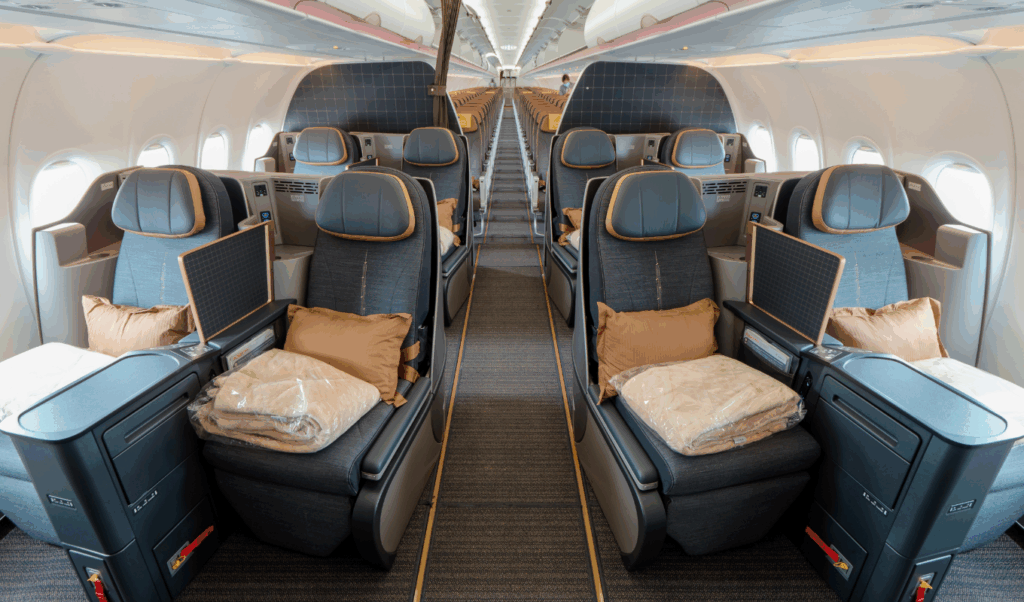
Business Class
Business class offers a blend of comfort and luxury, turning long flights into a more enjoyable experience. It’s a step up that many travelers value, especially for its ability to make journeys less taxing and more pleasant. Over the years, business class has become a sought-after option for passengers and airlines aiming to elevate travel standards.
Unlike premium economy, which provides a modest upgrade, business class takes things to a whole new level. Let’s dive into what sets business class apart, from seating and airport perks to dining, entertainment, and exclusive amenities.
Business Class Features and Amenities
The business class experience isn’t just about a bigger seat – it’s a complete upgrade that starts before you even board the plane and continues until you land. Here’s what you can expect:
Seating and Space
Business class seating offers a spacious upgrade, with seat pitches ranging from 60 to 80 inches, compared to the typical 30–32 inches in economy. Seats are also wider, measuring 20–26 inches, and many can recline fully into 180-degree lie-flat beds – perfect for overnight flights.
For example, Cathay Pacific’s Aria Suite, available on select Boeing 777-300ER aircraft, has earned accolades, including the 2025 Red Dot Design Award. This suite features a wrap-around design, privacy door, sliding partition, and a 24-inch 4K screen. It’s like having your own mini-hotel room in the sky.
Airport Perks
Business class passengers enjoy a range of VIP services, including priority check-in, expedited security, dedicated boarding lanes, and priority baggage handling. Lounge access is another highlight, offering amenities like Wi-Fi, charging stations, showers, and buffet dining. Plus, most airlines include two free checked bags with business class tickets.
Dining and Beverages
Expect thoughtfully curated menus and premium beverages. Many airlines partner with top chefs and mixologists to craft meals and cocktails that feel more like dining at a fine restaurant than eating on a plane. For instance, Delta Airlines recently introduced Taittinger Champagne in its Delta One cabins on international routes. Dine-on-demand services are also common, letting passengers order meals whenever they want.
Entertainment and Connectivity
Business class entertainment systems feature large screens and extensive content libraries. High-speed Wi-Fi is typically included, with some airlines now offering free Starlink connectivity. Universal power outlets ensure your devices stay charged throughout the flight.
Luxury Amenities
Amenity kits in business class are often a cut above. Qatar Airways, for example, offers Diptyque-branded kits with items like lip balm, body lotion, face cream, and signature fragrances. Emirates also provides lavish kits on long-haul overnight flights, setting a high standard for in-flight luxury.
Who Benefits Most from Business Class
Business Travelers and Executives
For professionals, business class is more than a luxury – it’s a productivity tool. Nearly all C-level executives (96%) believe that premium travel enhances their performance. Many report maintaining 80–90% productivity after a business class red-eye flight, compared to 40–60% after flying economy. On a 12-hour flight, the $2,000 premium for business class breaks down to about $167 per hour of added comfort.
Long-Haul International Travelers
On flights longer than eight hours, the perks of business class – like lie-flat seats and enhanced amenities – become even more valuable. These features can significantly reduce jet lag and make the journey far more comfortable.
Health and Mobility Considerations
For taller passengers, those with back issues, elderly travelers, or anyone recovering from medical procedures, the extra space and lie-flat seats can make a world of difference. Priority services also help streamline the travel experience.
Frequent Flyers
Regular travelers not only enjoy the comfort but also benefit from loyalty programs. These programs often lead to upgrades, priority status, and other perks that enhance future travel experiences.
Special Occasion Travelers
Whether it’s a honeymoon, anniversary, or another milestone, business class adds an extra layer of luxury to the celebration. The comfort and exclusivity make the journey as memorable as the destination itself.
Domestic business class fares in the U.S. range from $300 to $1,600 round trip, while international tickets can cost anywhere from $3,000 to over $10,000. However, savvy travelers often use miles, points, and smart booking strategies to enjoy these premium experiences at a fraction of the price.
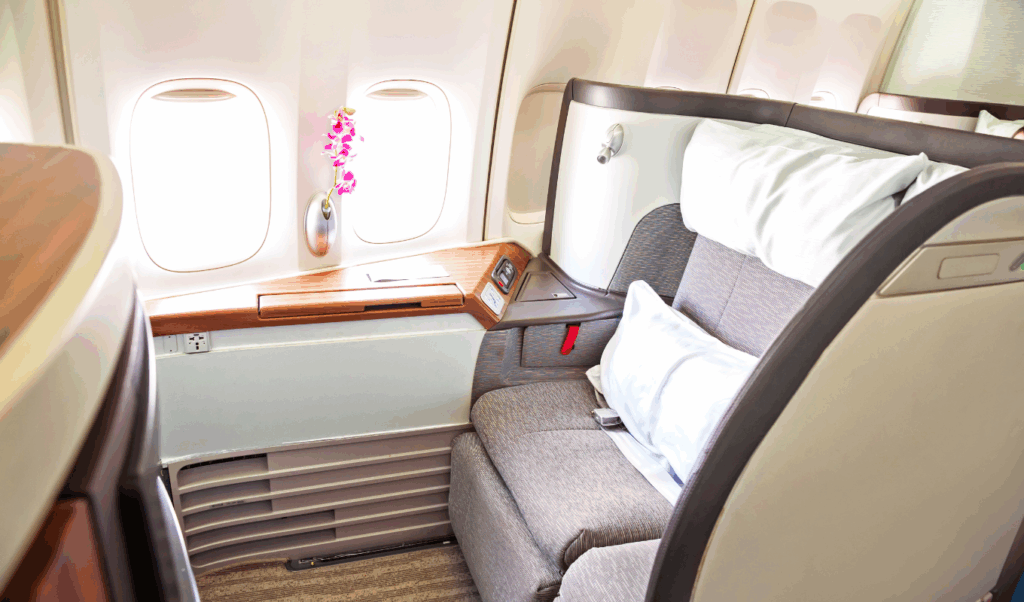
First Class
First class represents the pinnacle of airline luxury, delivering unmatched privacy, personalized service, and top-tier amenities. This level of indulgence comes at a steep price – typically 60% to 200% more than business class fares. For instance, a business class ticket from New York to Dubai might cost around $5,500, while first class on the same route could soar to nearly $22,000. From the moment you step into the airport, the differences are clear. Here’s a closer look at the exclusive features of first class and how it varies between domestic and international travel.
First Class Features
Private Suites and Spacious Design
First class cabins are designed for ultimate privacy, often featuring fully enclosed suites. These transform your seat into a personal sanctuary. Singapore Airlines’ A380 Suites stand out with 50 square feet of space per passenger, and some suites can even be combined into 100-square-foot “sky apartments” for couples. Cathay Pacific’s Boeing 777 first class offers seats with an impressive 36-inch width, ensuring maximum comfort.
Gourmet Dining and Premium Beverages
Dining in first class is an experience in itself, with menus crafted by Michelin-starred chefs and served on elegant tableware. For example, Air France’s La Première offers dishes by three Michelin-star chef Arnaud Lallement, while Japan Airlines features washoku menus that include delicacies like caviar with wagyu beef. The beverage options are equally impressive: Emirates boasts a $500-million wine collection, including Château Mouton Rothschild 2004, Korean Air serves 2006 Perrier-Jouët Belle Epoque Rosé Champagne, and ANA offers premium sakes alongside high-end champagnes.
Luxury Amenities and Cutting-Edge Technology
From high-end amenity kits to advanced in-flight tech, first class spares no expense. SWISS passengers enjoy La Prairie skincare products and Zimmerli pajamas, while Emirates passengers can indulge in Bulgari amenity kits and onboard shower suites with private spa sessions. Japan Airlines’ A350-1000 first class features 43-inch TV screens, and ANA’s “The Suites” on the Boeing 777-300ER include 42-inch screens with headrest speakers, as well as lavatories equipped with bidet toilets.
Personalized Service
First class service is unparalleled, with one flight attendant for every 1–3 passengers. This allows for highly personalized attention, with crew members catering to your preferences throughout the journey.
Exclusive Ground Services
The luxury experience begins long before takeoff. First class passengers enjoy perks like private check-in, exclusive lounges, and luxury transfers. Lufthansa’s First Class Terminal in Frankfurt includes private security checks, napping rooms, a cigar bar, and chauffeured Mercedes-Benz rides to the aircraft. Similarly, Air France’s La Première lounge at Paris Charles de Gaulle offers fine dining by Alain Ducasse and other premium services.
Domestic vs International First Class
The first class experience varies greatly depending on whether you’re flying domestically or internationally.
Domestic First Class in the U.S.
In the U.S., domestic first class offers larger seats, more legroom, priority boarding, and upgraded meals, but it lacks the extravagance of international first class. Lie-flat beds are rare, making it feel closer to international premium economy. American Airlines is even phasing out domestic first class in favor of Flagship suites, signaling a shift toward enhancing business class on domestic routes.
International First Class
International first class is where true luxury shines. Passengers enjoy private suites, lie-flat beds, gourmet meals, exclusive lounges, and high-end amenities. For example, Etihad’s “The Residence” offers a three-room suite with a living area, bedroom, and private shower, costing over $25,000 for a flight from New York to Abu Dhabi. On long-haul routes, these features make a significant difference, ensuring passengers arrive well-rested and ready to perform.
Who Should Choose First Class
Professionals Who Need Peak Performance
For business executives, surgeons, and other high-performing professionals, first class offers a chance to sleep comfortably, work in privacy, and minimize jet lag. These benefits can directly impact productivity upon arrival.
Travelers Celebrating Special Occasions
First class is perfect for marking life’s milestones – whether it’s a honeymoon, an anniversary, or a once-in-a-lifetime trip. The elevated experience turns travel into a memorable part of the celebration.
Affluent Travelers and Points Enthusiasts
For those who can afford the premium or have accumulated points and miles, first class offers unparalleled experiences. From Emirates’ onboard shower spa to Singapore Airlines’ expansive suites and Etihad’s multi-room apartments, the offerings redefine luxury travel.
The 2025 SKYTRAX awards named Singapore Airlines, Emirates, Air France, Cathay Pacific Airways, and Lufthansa as the top five first class carriers. Each delivers an extraordinary level of comfort, privacy, and service, making the investment worthwhile for those who value the ultimate in luxury travel.
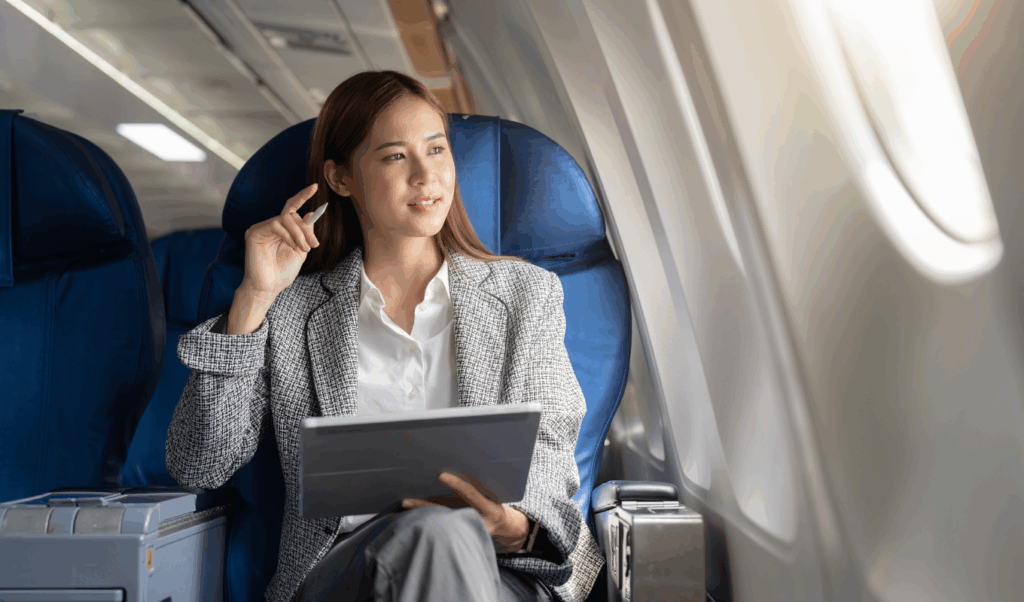
Seat Class Comparison
Airline seat classes differ in comfort, pricing, and perks, so your choice should align with your travel priorities. Whether you’re a budget-conscious family or a business traveler aiming to arrive rested and ready, each class offers something tailored to specific needs.
When it comes to prices, finding the right balance between comfort, flight duration, and budget is key. Services like Dollar Flight Club make premium travel more attainable, offering discounts of up to 90% on regular fares.
Seat Class Comparison Table
| Feature | Economy Class | Premium Economy | Business Class | First Class |
|---|---|---|---|---|
| Seat Width | 17–18 inches | 18–20 inches | 20–22 inches | 22–35 inches |
| Seat Pitch | 28–32 inches | 34–38 inches | 60–80 inches (lie-flat) | 60–87 inches (lie-flat) |
| Recline | 2–4 inches | 6–8 inches | 180° (lie-flat bed) | 180° (lie-flat bed) |
| Baggage Allowance | 1 carry-on + personal item | 1–2 checked bags included | 2–3 checked bags included | 3+ checked bags included |
| Meal Service | Basic meal or snack | Enhanced meal with wine | Multi-course gourmet dining | Chef-curated cuisine |
| Lounge Access | None (pay separately) | Limited or paid access | Complimentary access | Premium lounge access |
| Boarding Priority | Group 3–5 | Group 2–3 | Group 1–2 | First to board |
| Privacy | Minimal | Slightly enhanced | High (pods/suites) | Maximum (private suites) |
| Typical Price Range | $300–$1,500 | $800–$3,000 | $2,000–$8,000 | $5,000–$25,000+ |
| Best For | Budget travelers, short flights | Comfort seekers, long flights | Business travelers, couples | Luxury seekers, special occasions |
This table provides an overview of how each class serves different needs, from budget-friendly travel to high-end luxury.
But there’s more to consider than just the basics. Families, for instance, might appreciate features like Qatar Airways’ Qsuite or Singapore Airlines’ adjustable seating, which makes traveling with children easier by allowing configurations for better interaction. On the flip side, some business class layouts with widely spaced seats may make it harder for parents to keep an eye on little ones during critical moments of the flight.
For business professionals, business class often hits the sweet spot. It offers lie-flat beds, enhanced privacy, and workspace features. Products like Qatar Airways’ Qsuite or ANA’s “The Room” are designed to help travelers stay productive and refreshed upon arrival.
Flight deals can make these upgrades even more appealing. Dollar Flight Club members have saved thousands on trips, with examples like a Boston-to-Amsterdam route for $289 (64% off the standard $815 fare), making premium economy or business class upgrades well within reach. Another standout deal included a Los Angeles–Tokyo flight for $499, slashing 55% off the usual price.
Certain airlines also elevate the experience with thoughtful seating designs. Emirates’ A380 center seats, ANA’s “The Room” with adjustable privacy doors, and Qatar Airways’ Qsuite, which can transform into shared spaces, make long-haul flights far more enjoyable.
Ultimately, the choice comes down to your flight length, travel companions, and what matters most to you – whether that’s saving money, arriving well-rested, or enjoying every moment of the journey. Next, we’ll dive into strategies to help you snag these competitive fares.

How to Find Deals on Airline Seat Classes
Snagging deals on premium airline seats takes some planning and knowing where to look. Airlines use dynamic pricing that can shift frequently, but there are patterns and strategies that can help you save across all seat classes. Let’s break it down.
Timing plays a big role. According to KAYAK data, August often has the cheapest business class tickets, with smaller price drops also popping up in July and April. On the other hand, February tends to be the priciest month, though not by a huge margin. For reference, domestic business class flights average about $1,305, while international routes hover around $4,156. Even small discounts can make a noticeable difference at these prices.
Forget the old “Tuesday at 3 PM” rule – it doesn’t hold up anymore with today’s advanced pricing algorithms. Instead, flexibility with your travel dates is key. Flying on off-peak days like Tuesdays, Wednesdays, or Saturdays can save you 10–20% on international trips compared to busier days like Monday mornings or Friday evenings. School holidays can also be a sweet spot since business travel slows down, and airlines often discount premium seats to fill cabins.
Then there are mistake fares – those rare pricing errors that can slash business class tickets by as much as 90%. Imagine scoring an international business class ticket for just $300 instead of the usual $3,000. In 2020, around a dozen business class mistake fares were spotted, mostly for domestic, Caribbean, and Latin American routes. These deals are gold if you’re actively tracking fare trends.
Services like Dollar Flight Club are great for spotting these opportunities. They send out alerts for discounted business class flights, helping you stay ahead of the game. Below are some practical tips to help you secure these deals.
Tips for Finding Affordable Seat Class Deals
Once you’ve got your timing down, it’s time to use the right tools and strategies. Start by setting up price alerts on platforms like Google Flights, KAYAK, and Skyscanner to track fare changes for your target routes. Don’t forget to check airline websites directly – they sometimes run private sales that aren’t advertised elsewhere. Websites like Flyfirst, Skylux Travel, and Etravelbid can also help negotiate lower fares, even for last-minute trips.
Keep an eye on award space for premium seats, especially when schedules are first released or just before departure. Loyalty programs and credit card points can also be game-changers. Upgrading to business class often doesn’t require triple the miles compared to economy, making it a smart way to stretch your points. Signing up for travel rewards credit cards with big bonuses and joining airline loyalty programs can boost your chances of scoring upgrades – even at the entry level.
Take advantage of upgrade opportunities through various channels. Some airlines offer upgrade auctions, and bidding at least 25% above the minimum can increase your odds. Additionally, check for last-minute upgrade discounts during online check-in or at airport kiosks – unsold premium seats often go for a fraction of their usual price.
Consider alternative airports and routes to find better deals. Flying into smaller, nearby airports can sometimes be cheaper. Adding a Saturday night stay to your itinerary can also reduce premium cabin prices. If your employer offers corporate travel discounts, you might score 10–20% off standard rates.
When it comes to payment, timing matters. For cash bookings, try to purchase first-class tickets at least seven days in advance, as last-minute bookings can cost up to 40% more. However, if you’re using points, award space for business and first class often becomes available either when schedules are first posted or right before departure.
The key is to stay flexible, set alerts, and act fast when a deal pops up. By combining tools like price trackers, loyalty programs, and services like Dollar Flight Club, you can turn premium travel into a more affordable reality.
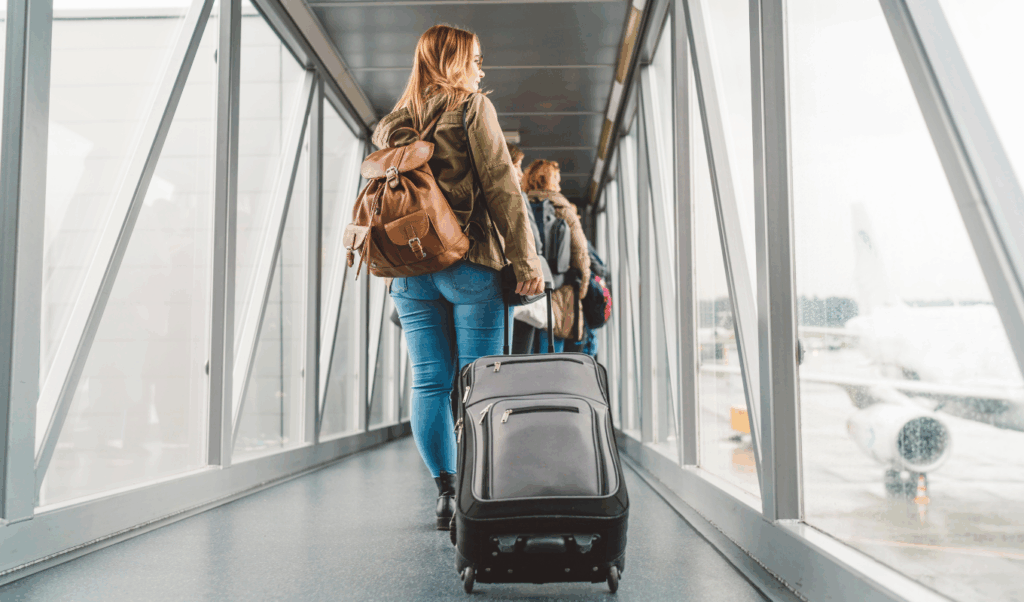
Conclusion
This guide has broken down the perks and costs of each seat class, helping you match your choice to your comfort, budget, and travel priorities.
Economy class is the go-to option for travelers keeping an eye on their wallets. It’s perfect for short domestic trips or anyone who values saving money over extra amenities. Premium economy steps things up a notch, offering added comfort and improved service without breaking the bank. This makes it a solid pick for long-haul flights when you want a bit more ease without committing to the price of business class.
Business class shines on international or overnight flights, especially when arriving refreshed is a priority. With perks like lie-flat seats and direct aisle access, those long hours in the air become far more manageable. While business class typically costs 3–5 times more than economy, the added productivity and comfort can make it worth the splurge.
First class takes luxury to a whole new level. However, it’s smart to weigh the differences between first and business class on your specific route, as some airlines have replaced first class with enhanced business options. The steep pricing makes first class most appealing when you’re using points, snagging a deal, or treating yourself to an unforgettable travel experience.
The secret to making the most of your travel budget is staying flexible and informed. Airfare prices fluctuate constantly, and services like Dollar Flight Club can help you spot those rare deals where premium cabins become surprisingly affordable. Whether you’re chasing a mistake fare or stretching your dollars, timing and the right tools can open the door to premium travel.
Keep in mind, not every aircraft offers all four seat classes, so research your specific flight to find the best options. The airline itself plays a big role too – some carriers’ business class offerings rival others’ first class. Compare what each airline provides in your chosen class and consider the full travel experience, including extras like airport lounges, priority boarding, and baggage allowances.
Ultimately, the best choice is the one that balances comfort, value, and convenience, ensuring your journey is as enjoyable as possible.
FAQs
How do I choose the best airline seat class for my travel needs?
Choosing the right airline seat class boils down to your budget, comfort needs, and the purpose of your trip. Economy class is the go-to choice for travelers prioritizing affordability, offering standard seating and basic amenities. If you’re looking for a bit more comfort, premium economy steps it up with extra legroom, wider seats, and enhanced services – though it does come with a higher price tag. For those seeking a more luxurious experience, business class delivers perks like lie-flat seats, gourmet meals, and access to exclusive lounges, making it a great option for long-haul flights or work-related travel. At the top of the spectrum, first class offers unmatched comfort, privacy, and top-tier service, but it’s a splurge reserved for those willing to pay a premium.
When planning a long flight, upgrading to premium economy or business class can make a world of difference. Think about the trip duration, how much space you’ll need, and which amenities are most important to you. Striking the right balance between cost and comfort ensures you get the best value for your journey.
How can I find deals on business or first-class airline tickets?
Finding great deals on premium seats, like business or first class, doesn’t have to break the bank if you know a few tricks. Start by booking early – aim for at least 21 days ahead of your trip. Staying flexible with your travel dates can also make a big difference. Flights on midweek days like Tuesday or Wednesday, or even Saturdays, often come with lower fares. Another option? Keep an eye out for last-minute upgrades at check-in or take part in upgrade auctions to snag luxury seating at a fraction of the usual cost.
You can also sign up for services that send alerts for discounted flights. These tools can help you find premium cabin deals for both domestic and international routes. With a little planning and the right strategies, you can enjoy the perks of flying in style without overspending.
Which airlines are known for offering exceptional service in specific seat classes?
Some airlines are known for excelling in specific seat classes, offering travelers a standout experience. For premium economy, carriers like Virgin Atlantic, Japan Airlines, Emirates, and Singapore Airlines often earn praise for their comfortable seating and thoughtful amenities. In business class, Singapore Airlines frequently takes the spotlight with its cutting-edge cabin design and exceptional service. Meanwhile, in first class, Cathay Pacific is celebrated for delivering a truly luxurious journey paired with outstanding hospitality.
These airlines consistently raise the bar, making them popular choices for those looking to enjoy a premium travel experience.

